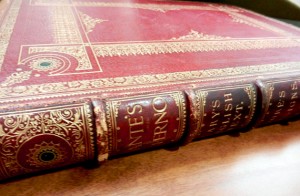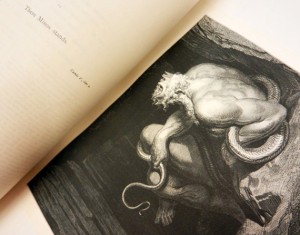
In addition to the over 7,000 linear feet of archival collections made available for study at the University of Houston Special Collections, we are also proud to offer over 100,000 rare and antique books for use in our reading room. Each month (some more dutifully than others) we will highlight a text from our collections and what makes it so special.
In the spring 2015 semester we had the good fortune to host our first-ever UH Special Collections Social Media Intern, Shelby Love. As part of her duties, Love curated a number of selections for our Book of the Month series here on the blog. For this month (and many to come, no doubt) we share a Book of the Month selection from Shelby Love.
Book of the Month: The Vision of Hell by Dante Alighieri, translated by Henry Francis Cary, and illustrated with the designs of M. Gustave Doré.

“Abandon all hope, ye who enter here.” The Vision of Hell by Dante Alighieri
Why so Special? In this 1866 edition, Dante Alighieri’s literary masterpiece is skillfully presented through the two archetypal interpretations of Henry Francis Cary and M. Gustave Doré. Cary, a graduate of Christ Church College, Oxford and assistant librarian in the British Museum, translated the Divine Comedy from Italian to English in the early 1800s. Despite the availability of numerous alternative translations, Cary’s version remained the standard into the twentieth century. That would be over 100 years of beating his competitors. In fact, his poetic translation was admired by other literary giants such as Wordsworth, Keats, Lamb, Coleridge, Macaulay, and Ruskin. Cary dedicated countless hours and even his own funds to complete the project for public consumption, truly a meritorious example of just how important our librarians are to society.
The second distinguished interpretation is through Doré’s vivid illustrations of the otherworldly adventure. Doré was an incredibly successful and productive French illustrator and printmaker in the 19th century known for his imaginative and fantastical artwork. His work was mainly centered around themes like the (pessimistic) fate of mankind and meditations on life and death, making him and Dante such a compatible ideological pair, the likes of which even match.com couldn’t hope to recreate. In fact, one contemporary critic found the illustrations to be so conscientious that he suggested Doré and the long deceased Dante were communicating through the occult. Dante enthusiasts and scholars still consider Doré a determiner for how the Divine Comedy is visualized by readers today, ranking his hypnotic renderings along with those of Sandro Botticelli, William Blake, Eugène Delacroix, and even Michael Angelo.
With a detailed red and gold hardcover, this edition is one of the most eye-catching items among our larger-format books. The sheer size of it can strike the modern day book lover as both whimsical and puzzling, eliciting the question, why would such a serious classic need to be so colossal? A rewarding perusal in the reading room will reveal a uniquely intimate way to engage with Dante’s beloved classic as Cary’s poetic translation of the writer’s imaginative vision is presented side by side with Doré’s exquisite renditions of the literary masterpiece. This incredible edition contains the crowning achievements of three fruitful lifetimes, brought together by one vision.
Location: Those interested in consulting with this edition of Dante’s classic may request call number PQ4315.2 .C4 1866 in the Special Collections Reading Room.
